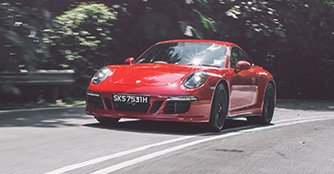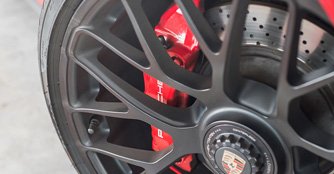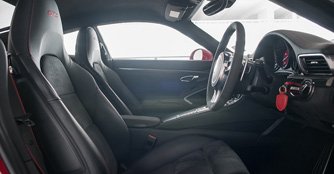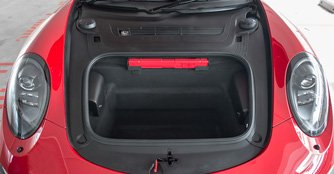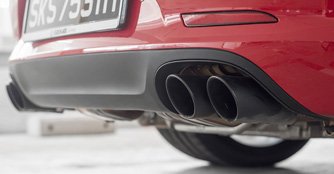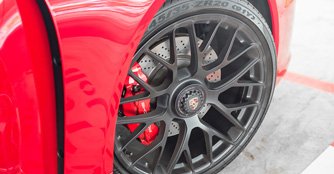Porsche 911 Carrera GTS PDK 3.8 (A) Review
04 Jan 2016|13,736 views
Porsche's 911 lineup covers a wide variety of performance possibilities - from the base Carrera to the high-powered Turbo and Turbo S, as well as the top-of-the-line GT3 and GT3 RS. But as it turns out, the Stuttgart sports carmaker realised there was still a slot in the range. And the new Carrera GTS has now filled this slot.
This model bridges the gap between the very quick Carrera S and the track-oriented Carrera GT3. Four iterations are available and they include all-wheel and rear-wheel drive options for both cabriolet and coupe body styles, with the latter combination being the car you see here.
Exterior
Porsche aficionados will easily tell the Carrera GTS from its lesser siblings. The sheet metal doesn't feature a whole lot of extras, but there's enough there to let you and bystanders know it's something special.
Smoked Bi-Xenon head lights are standard, as are black 20-inch centre-lock wheels. There is also a black rear air intake designed to resemble those on historic 911 models, and this is exclusive to the GTS.
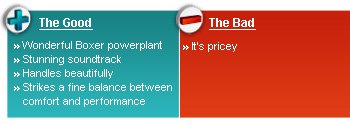 |
The car comes with the same wide body design and pushed-out rear track featured on the Carrera 4S regardless of whether you order all-wheel drive or not. Rear-wheel driven models also get their own exclusive strip that connects the taillights and mimics an air vent while those with four driven wheels feature a stretched light band.
For those who still don't know what they're looking at, Porsche's design department has added helpful 'GTS' stickers to the doors, reminding everybody that this is more than just a Carrera S.
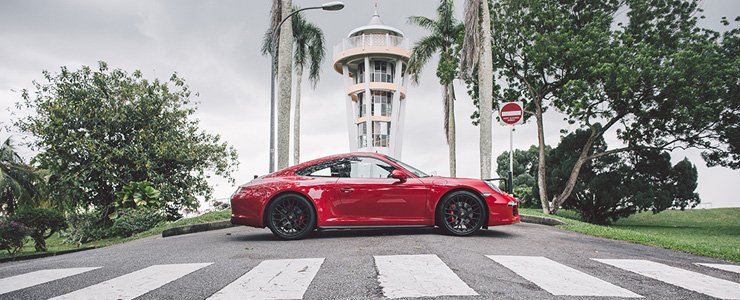 |
Interior
While the 911's exterior is stylistically convincing, the interior often divides opinion. Some call it classic, while others may refer to it as a confusing array of buttons.
Part of the 'classic' appeal is perhaps the older style gauges for engine and oil temperature. Instead of using a digital display, they are traditional analogue gauges and give the 911 an appeal that is unmatched by other sports cars of today.
On the other hand, the centre console has dials for almost everything, from the sport modes in the central console, to the switches for the auto start/stop, the spoiler, damping, stability control and exhaust.
In combination with the standard interior colour, the centre sections of the sports seats are covered with high-quality black Alcantara.
The material is also used wherever driver and passenger come in direct contact with the interior, such as on parts of the dash, the three-spoke SportDesign steering wheel and on the gear levers, where it adds an extra level of tactility.
Like the rest of the 911s, the rear seats are essentially unusable unless you are a small child. But looking on the bright side, they are there if you ever need to ferry anybody legally in the back.
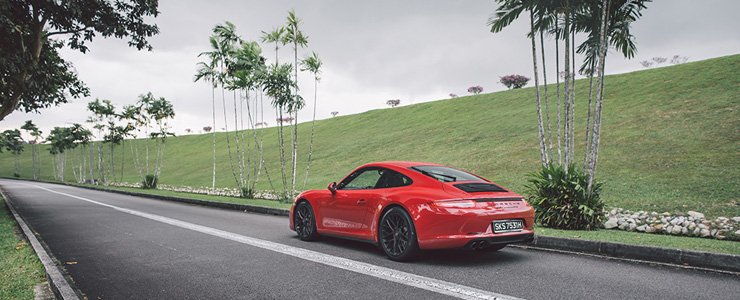 |
The Drive
Mounted at the rear is Porsche's famed 3.8-litre flat six-cylinder Boxer engine that delivers 430bhp (30 more horses than the Carrera S') along with 440Nm of torque.
Being a naturally aspirated engine, the bulk of its power and torque is produced high in the rev range. But throughout the entire spectrum, there is no lack of capability and it's a genuine bacchanalia of noise, soul and ecstasy.
Throttle response is razor sharp in the regular driving mode, but becomes even edgier as you progress through the Sport and Sport Plus modes.
Like a shape-shifting mythological creature, the car will turn into whatever kind of nasty animal you can think of once you go heavy on the pedal. Its crushing acceleration will get you to three-digit speeds in four seconds flat and what comes after that will attract attention from the law enforcers or their newly setup imaging devices.
The Porsche Doppelkupplung (PDK) transmission performs like a well-oiled device, always upshifting and downshifting gears at the right time. For more control, the paddle shifters on the steering wheel work like a charm, but honestly, this dual-clutch gearbox is already a wonder when left to its own devices.
Mounted at the rear is Porsche's famed 3.8-litre flat six-cylinder Boxer engine that delivers 430bhp (30 more horses than the Carrera S') along with 440Nm of torque.
Being a naturally aspirated engine, the bulk of its power and torque is produced high in the rev range. But throughout the entire spectrum, there is no lack of capability and it's a genuine bacchanalia of noise, soul and ecstasy.
Throttle response is razor sharp in the regular driving mode, but becomes even edgier as you progress through the Sport and Sport Plus modes.
Like a shape-shifting mythological creature, the car will turn into whatever kind of nasty animal you can think of once you go heavy on the pedal. Its crushing acceleration will get you to three-digit speeds in four seconds flat and what comes after that will attract attention from the law enforcers or their newly setup imaging devices.
The Porsche Doppelkupplung (PDK) transmission performs like a well-oiled device, always upshifting and downshifting gears at the right time. For more control, the paddle shifters on the steering wheel work like a charm, but honestly, this dual-clutch gearbox is already a wonder when left to its own devices.
Blessed with a wider body and rear track, plus revised settings for the standard fit Porsche Active Suspension Management and a 10mm lowered ride height, the Carrera GTS possesses improved handling over the Carrera S.
While remaining firm, the car turns in with the precision of a sharpshooter. It slices through corners with phenomenal pace, mainly thanks to the rigid chassis, dynamic suspension and huge amount of grip.
Conclusion
Combining the best bits of the demure and the devious means that the Porsche 911 Carrera GTS must maintain a fine balance of providing both comfort for the street and terror for the track. And at the risk of giving it all away, it succeeds fantastically in that mission.
So if you have the cash ($565,188 without COE as of 24th December 2015), you can consider making a trip down to Porsche's showroom.
While remaining firm, the car turns in with the precision of a sharpshooter. It slices through corners with phenomenal pace, mainly thanks to the rigid chassis, dynamic suspension and huge amount of grip.
Conclusion
Combining the best bits of the demure and the devious means that the Porsche 911 Carrera GTS must maintain a fine balance of providing both comfort for the street and terror for the track. And at the risk of giving it all away, it succeeds fantastically in that mission.
So if you have the cash ($565,188 without COE as of 24th December 2015), you can consider making a trip down to Porsche's showroom.
Porsche's 911 lineup covers a wide variety of performance possibilities - from the base Carrera to the high-powered Turbo and Turbo S, as well as the top-of-the-line GT3 and GT3 RS. But as it turns out, the Stuttgart sports carmaker realised there was still a slot in the range. And the new Carrera GTS has now filled this slot.
This model bridges the gap between the very quick Carrera S and the track-oriented Carrera GT3. Four iterations are available and they include all-wheel and rear-wheel drive options for both cabriolet and coupe body styles, with the latter combination being the car you see here.
Exterior
Porsche aficionados will easily tell the Carrera GTS from its lesser siblings. The sheet metal doesn't feature a whole lot of extras, but there's enough there to let you and bystanders know it's something special.
Smoked Bi-Xenon head lights are standard, as are black 20-inch centre-lock wheels. There is also a black rear air intake designed to resemble those on historic 911 models, and this is exclusive to the GTS.
The car comes with the same wide body design and pushed-out rear track featured on the Carrera 4S regardless of whether you order all-wheel drive or not. Rear-wheel driven models also get their own exclusive strip that connects the taillights and mimics an air vent while those with four driven wheels feature a stretched light band.
For those who still don't know what they're looking at, Porsche's design department has added helpful 'GTS' stickers to the doors, reminding everybody that this is more than just a Carrera S.
Interior
While the 911's exterior is stylistically convincing, the interior often divides opinion. Some call it classic, while others may refer to it as a confusing array of buttons.
Part of the 'classic' appeal is perhaps the older style gauges for engine and oil temperature. Instead of using a digital display, they are traditional analogue gauges and give the 911 an appeal that is unmatched by other sports cars of today.
On the other hand, the centre console has dials for almost everything, from the sport modes in the central console, to the switches for the auto start/stop, the spoiler, damping, stability control and exhaust.
While the 911's exterior is stylistically convincing, the interior often divides opinion. Some call it classic, while others may refer to it as a confusing array of buttons.
Part of the 'classic' appeal is perhaps the older style gauges for engine and oil temperature. Instead of using a digital display, they are traditional analogue gauges and give the 911 an appeal that is unmatched by other sports cars of today.
On the other hand, the centre console has dials for almost everything, from the sport modes in the central console, to the switches for the auto start/stop, the spoiler, damping, stability control and exhaust.
In combination with the standard interior colour, the centre sections of the sports seats are covered with high-quality black Alcantara.
The material is also used wherever driver and passenger come in direct contact with the interior, such as on parts of the dash, the three-spoke SportDesign steering wheel and on the gear levers, where it adds an extra level of tactility.
Like the rest of the 911s, the rear seats are essentially unusable unless you are a small child. But looking on the bright side, they are there if you ever need to ferry anybody legally in the back.
The Drive
Mounted at the rear is Porsche's famed 3.8-litre flat six-cylinder Boxer engine that delivers 430bhp (30 more horses than the Carrera S') along with 440Nm of torque.
Being a naturally aspirated engine, the bulk of its power and torque is produced high in the rev range. But throughout the entire spectrum, there is no lack of capability and it's a genuine bacchanalia of noise, soul and ecstasy.
Throttle response is razor sharp in the regular driving mode, but becomes even edgier as you progress through the Sport and Sport Plus modes.
Like a shape-shifting mythological creature, the car will turn into whatever kind of nasty animal you can think of once you go heavy on the pedal. Its crushing acceleration will get you to three-digit speeds in four seconds flat and what comes after that will attract attention from the law enforcers or their newly setup imaging devices.
The Porsche Doppelkupplung (PDK) transmission performs like a well-oiled device, always upshifting and downshifting gears at the right time. For more control, the paddle shifters on the steering wheel work like a charm, but honestly, this dual-clutch gearbox is already a wonder when left to its own devices.
Mounted at the rear is Porsche's famed 3.8-litre flat six-cylinder Boxer engine that delivers 430bhp (30 more horses than the Carrera S') along with 440Nm of torque.
Being a naturally aspirated engine, the bulk of its power and torque is produced high in the rev range. But throughout the entire spectrum, there is no lack of capability and it's a genuine bacchanalia of noise, soul and ecstasy.
Throttle response is razor sharp in the regular driving mode, but becomes even edgier as you progress through the Sport and Sport Plus modes.
Like a shape-shifting mythological creature, the car will turn into whatever kind of nasty animal you can think of once you go heavy on the pedal. Its crushing acceleration will get you to three-digit speeds in four seconds flat and what comes after that will attract attention from the law enforcers or their newly setup imaging devices.
The Porsche Doppelkupplung (PDK) transmission performs like a well-oiled device, always upshifting and downshifting gears at the right time. For more control, the paddle shifters on the steering wheel work like a charm, but honestly, this dual-clutch gearbox is already a wonder when left to its own devices.
Blessed with a wider body and rear track, plus revised settings for the standard fit Porsche Active Suspension Management and a 10mm lowered ride height, the Carrera GTS possesses improved handling over the Carrera S.
While remaining firm, the car turns in with the precision of a sharpshooter. It slices through corners with phenomenal pace, mainly thanks to the rigid chassis, dynamic suspension and huge amount of grip.
Conclusion
Combining the best bits of the demure and the devious means that the Porsche 911 Carrera GTS must maintain a fine balance of providing both comfort for the street and terror for the track. And at the risk of giving it all away, it succeeds fantastically in that mission.
So if you have the cash ($565,188 without COE as of 24th December 2015), you can consider making a trip down to Porsche's showroom.
While remaining firm, the car turns in with the precision of a sharpshooter. It slices through corners with phenomenal pace, mainly thanks to the rigid chassis, dynamic suspension and huge amount of grip.
Conclusion
Combining the best bits of the demure and the devious means that the Porsche 911 Carrera GTS must maintain a fine balance of providing both comfort for the street and terror for the track. And at the risk of giving it all away, it succeeds fantastically in that mission.
So if you have the cash ($565,188 without COE as of 24th December 2015), you can consider making a trip down to Porsche's showroom.
Car Information
Porsche 911 Carrera GTS PDK 3.8 (A)
CAT B|Petrol|11.5km/L
Horsepower
321kW (430 bhp)
Torque
440 Nm
Acceleration
4sec (0-100km /hr)
This model is no longer being sold by local distributor
All Used Porsche 911 CarreraThank You For Your Subscription.





























